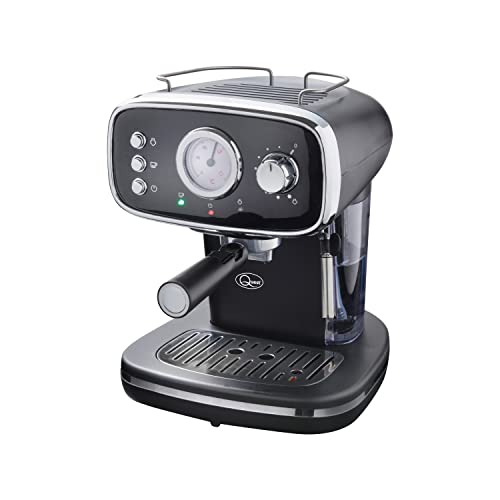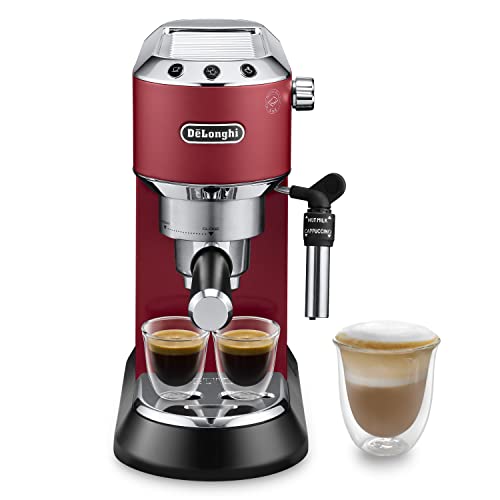The Next Big New Espresso Machine Coffee Industry
페이지 정보

본문
 How to Make Espresso Machine Coffee
How to Make Espresso Machine Coffee Espresso machines espresso machines can create an excellent cup of coffee, but they require more maintenance and setup than a typical coffee maker. It also requires you to grind and espresso coffee machines for sale make your own coffee.
Espresso machines espresso machines can create an excellent cup of coffee, but they require more maintenance and setup than a typical coffee maker. It also requires you to grind and espresso coffee machines for sale make your own coffee.The primary ingredient to make espresso is pressure. What happens in an espresso machine is that a heating vessel heats the water to the perfect temperature, then it forces it out from the spouts into the grounds.
Temperature
Espresso is created by forcing hot water under pressure through finely ground coffee beans. The temperature of the water is essential to the quality of the final shot. Low temperatures result in under extraction of the essential flavor compounds. The high temperatures cause excessive extraction and can cause a bitter or burnt taste.
The ideal temperature range for espresso is 195-205degF. This temperature is reached by using an espresso machines home group head that has been designed to maintain the same temperature and stability throughout the brewing cycle. The most popular type of group head is the E61, which provides the stability of temperature, pre-infusion capabilities, and lever control.
When making adjustments to the espresso machine for different roasts and brew ratios it is crucial to take into consideration the effect of temperature on extraction yield as well as crema. The ideal temperature will differ according to the roast and bean. However it is a general rule that lighter roasts with higher brew rates need higher temperatures. In addition, a high thermocouple is crucial in ensuring a consistent temperature.
Pressure
In the process of brewing, espresso machine coffee is pushed under pressure through finely ground coffee grounds that have been put through a tamper. This causes chemical reactions to extract flavors, oils and other soluble ingredients from the beans. The resulting beverage is typically richer and more flavorful than regular coffee.
The ideal espresso machine's pressure should be nine bars equivalent to sea-level pressure. The soluble compounds in the espresso bean are best home espresso machine extracted at this pressure.
However, some espresso machines may advertise 15 or 20 bars of pressure. These machines could reach these pressure levels, but they may not maintain them throughout the extraction.
To put it into perspective For a better understanding, one bar is equivalent to 32 pounds per square inch PSI of the tire of a car. It's more than four times the pressure that professional cyclists use when filling their bike tires. The ability to control the espresso machine's pressure and make consistent espressos is the key to any serious home barista.
Water
Water is the most important ingredient in a good cup of espresso. The correct water will allow your beans to extract their maximum potential. However the wrong kind of water can cause issues such as clogged pipes, or damage to your expensive machine.
The best option is natural spring water that is high in minerals for optimal espresso extraction. This water will enhance the taste of your espresso coffee machines for sale [atavi.com official] without the chalky mineral traces found in tap water or bottled waters. This is a great alternative to distilled or reverse osmosis filtered water, which can be too pure and cause problems with flavor.
You should not utilize a water filtration device that removes the mineral content of your tap water. This can result in flavor and extraction problems. A good solution is to purchase an instrument for testing water, which will give you the average hardness of your water in your area. This information can be used in determining the best filtration system for your espresso machine.
Beans
Most coffee lovers tend to be involved in the entire process of making espresso. They obsess about a number variables, such as temperature, pressure in the water and viscosity. If one variable is off even slightly the whole shot may taste bad.
The beans used are the most important aspect when it comes to espresso. It is often believed that only certain types of beans work well for espresso. While some beans are better to be used for specific purposes, any roasted bean can be used to make espresso. The main difference between espresso machine small beans and regular coffee beans is that espresso beans are roasted for longer in tipycally, espresso coffee machines for sale well past the second crack which gives them more of a dark appearance and makes them more water-soluble.
Medium or dark roast beans are ideal for espresso as they impart the espresso with richness and boldness. Light roasted beans can also be used to make fantastic espresso, particularly if they are pre-ground to make it easier to use an espresso maker.
Milk
Espresso and milk are a classic combination. The combination of milk and espresso is the most popular. Not only does it boost energy however, it also balances the bitterness of the espresso. There are few culinary duos better than this one!
If you decide to get an espresso machine that is able to make cappuccino or lattes make sure you examine how easy it is to use. The best espresso machine under 500 espresso machines feature a jug that can be filled with hot or cold milk along with a steam wand as well as portafilters for pulling the shot. Some models also come with a built-in grinder, tamper and frother.
The steam wand needs to be purged before using it for the first time in a day (or after every cup of espresso) to remove any condensed water. This process will take around 30 seconds and is important to keep your machine operating smoothly. If you don't purge, it can cause bitter taste and/or buildup of bacteria which can affect the flavor or smell of your beverage. It's not difficult to do and should be a part of your routine maintenance.
- 이전글Guide To Best Automatic Vacuum Cleaner: The Intermediate Guide To Best Automatic Vacuum Cleaner 25.02.07
- 다음글15 Things You're Not Sure Of About Espresso Coffee Maker 25.02.07
댓글목록
등록된 댓글이 없습니다.

